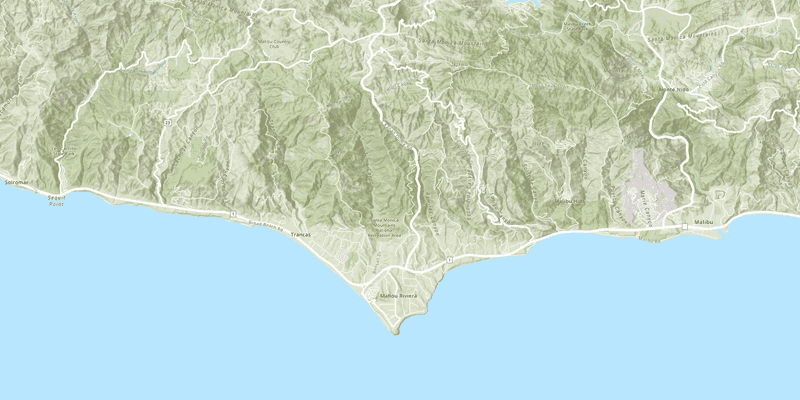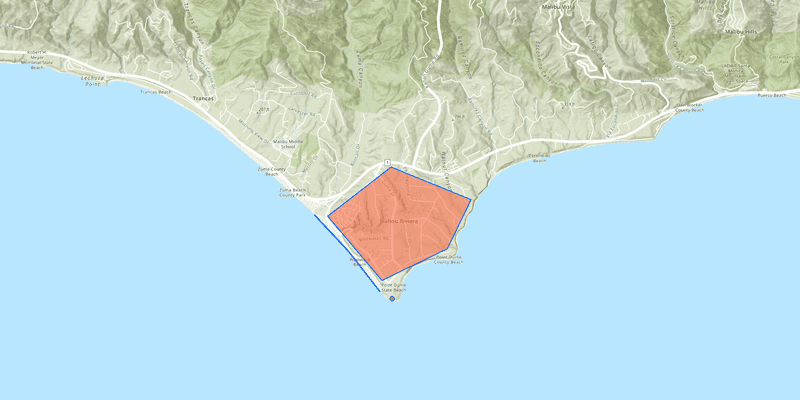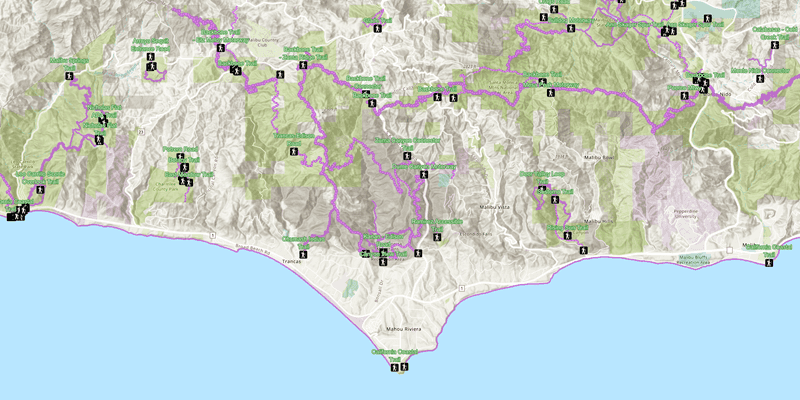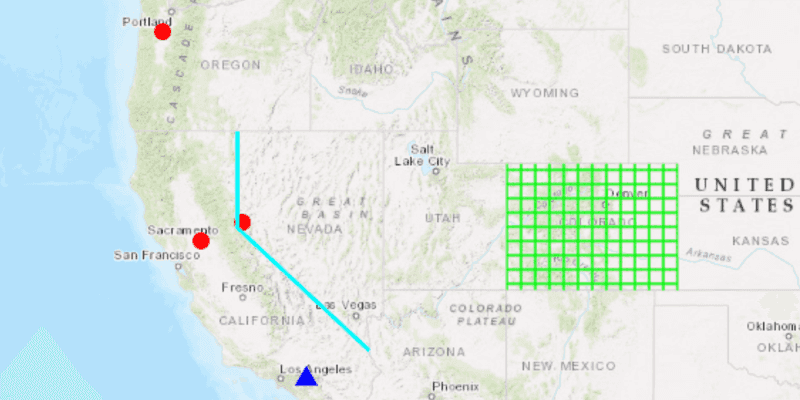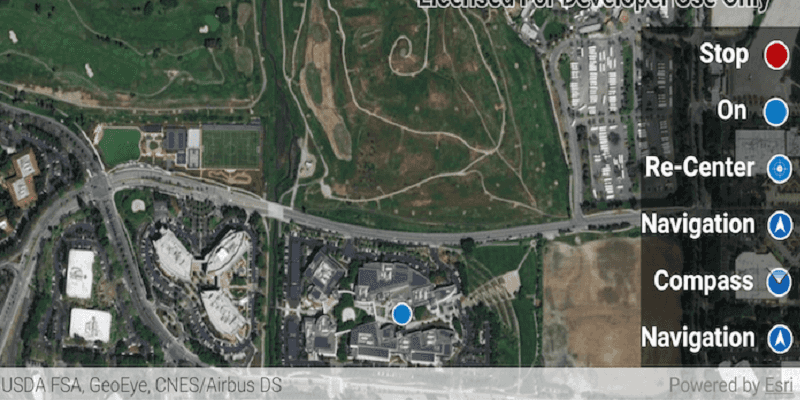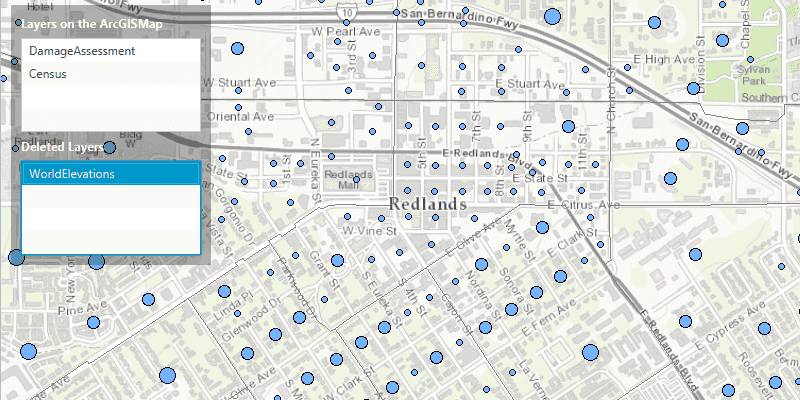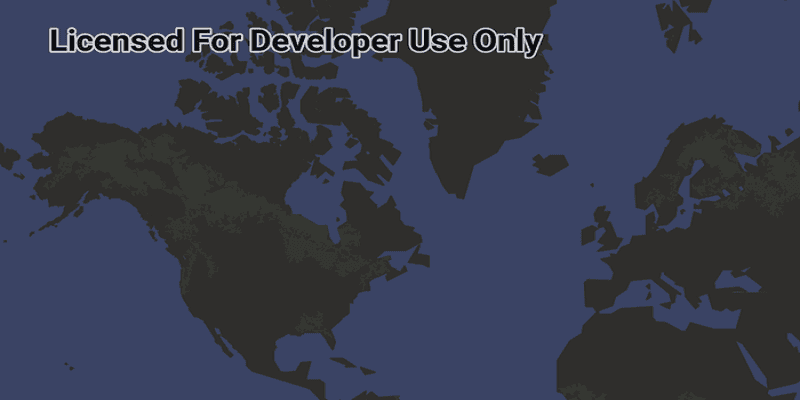Maps and scenes provide interactive displays of geographic data that enable you to visualize and explore patterns, answer questions, and share insight. They can be opened, edited, and shared across the ArcGIS system and beyond. Maps are designed for interaction in two dimensions (2D) and scenes for interaction in three dimensions (3D).
See Scenes (3D) in this guide for more information about working with scenes.You can use a map to:
- Display a basemap layer such as streets or satellite imagery.
- Access and display data layers based on files or services, including data you have authored.
- Provide context for temporary points, lines, polygons, or text displayed as graphics.
- Inspect data layers and display information from attributes.
- Measure distance and explore spatial relationships between geometries.
- Save a collection of layers as a web map to be shared across ArcGIS.
How a map works
A map works together with a map view to display geographic content in two dimensions. A map contains a collection of layers including multiple data layers from online or local sources, and a basemap layer that gives geographic context. A map can also contain datasets that enable searches for addresses or place names, networks for solving routes, utility networks for tracing the flow of services such as water and electricity, and non-spatial tables. Maps can be created, displayed, edited, and saved. Because the format is based on the ArcGIS web map standard, these maps can be shared uniformly across the ArcGIS system.
For offline workflows (when you don't have network connectivity), you can open a map stored in a mobile map package. Mobile map packages can be created using ArcGIS Pro, ArcGIS Enterprise, or ArcGIS Online. See Offline maps, scenes, and data for more information about implementing offline workflows in your apps.
Map
A map contains a collection of layers displayed in the order in which they were added, with the most recently added layer being displayed above existing layers. You can use the map to change the display order of layers as well as to control which layers are visible, and expose this functionality with user interface controls such as lists, check boxes, or switches. A map also contains a collection of bookmarks, which, similar to a web browser bookmark, allow you to quickly navigate to a predefined area of the map.
You can open an existing map or create one entirely with code. To create a map, you typically first add a basemap layer and then one or more data layers.
// API key authentication or user authentication is required to access basemaps
// and other location services.
ArcGISEnvironment.apiKey = ApiKey.create(YOUR_ACCESS_TOKEN)
// Create a map with an ArcGIS basemap style.
val map = ArcGISMap(BasemapStyle.ArcGISTopographic)
You can also open a map stored in a portal (such as ArcGIS Online) using its URL.
// Create an ArcGIS Map instance from a web map URL.
val webMap = ArcGISMap("https://www.arcgis.com/home/item.html?id=acc027394bc84c2fb04d1ed317aac674")
You can define the initial extent at which the map will display by setting the ArcGISMap.initialViewpoint property.
Layer
Each layer in a map references geographic data, either from an online service or from a local dataset. There are different types of layers that can be added to a map, each designed to display a particular type of data. Some layers display images, such as satellite imagery or aerial photography, while others are composed of a collection of features to represent real-world entities using point, line, or polygon geometries. In addition to geometry, features have attributes that provide details about the entity it represents.
The Layer class is the base class for all types of layers. The type of layer you create depends on the type of data you want to display. For example, to display feature data you can create a FeatureLayer that references an online service (such as a feature service) or a supported local dataset.
ArcGISEnvironment.apiKey = ApiKey.create(YOUR_ACCESS_TOKEN)
val arcGISMap = ArcGISMap(BasemapStyle.ArcGISTopographic)
val trailheadsLayer = FeatureLayer.createWithFeatureTable(
ServiceFeatureTable("https://services3.arcgis.com/GVgbJbqm8hXASVYi/arcgis/rest/services/Trailheads_Styled/FeatureServer/0"))
val trailsLayer = FeatureLayer.createWithFeatureTable(
ServiceFeatureTable("https://services3.arcgis.com/GVgbJbqm8hXASVYi/arcgis/rest/services/Trails_Styled/FeatureServer/0"))
val openSpacesLayer = FeatureLayer.createWithFeatureTable(
ServiceFeatureTable("https://services3.arcgis.com/GVgbJbqm8hXASVYi/arcgis/rest/services/Parks_and_Open_Space_Styled/FeatureServer/0"))
arcGISMap.operationalLayers.addAll(listOf(openSpacesLayer, trailsLayer, trailheadsLayer))
// Display the map by assigning it to the mutable map property used by the Composable MapView.
map = arcGISMap
MapView
A map view is a user-interface control that displays a single map in your app. It contains built-in functionality that allows the user to explore the map by zooming in and out, recentering the map display, or getting additional information about elements in the map. It also manages graphics in one or more collections of graphics overlays. The graphics managed by the map view always display above all layers displayed in the map.
A map view control also allows you to:
- Access data for data layers and graphics.
- Display the current location as a point on the map.
- Identify and select features at a specified location.
- Export an image of the current display.
- Rotate the map display.
- Apply a time extent to filter the display of features.
- Filter layer data using attribute and spatial criteria.
Add a map to a MapView control to display it. Changes you make to the map, such as adding, removing, or reordering layers, will immediately be reflected in the map view display. The ArcGISMap.initialViewpoint property will determine the area of the map shown when the map loads. You can also use Toolkit_MapView_SetViewpoint and Toolkit_MapView_SetViewpointRotation to programmatically change the map area or orientation shown in the display.
After creating a map, you set an initial viewpoint and then add the map to the map view:
map.initialViewpoint = Viewpoint(34.0270, -118.8050, 72000.0)
MapView(
modifier = Modifier.fillMaxSize(),
// Pass the map to the Composable MapView.
arcGISMap = map
)
Examples
Create and display a map
You can display a basic map by creating one with a basemap layer, setting its initial extent, and adding it to a map view. To learn how to add additional data, see the Layers topic.
Steps
- Create a new
ArcGISMap, passing aBasemapStyleinto the constructor. - Optionally, add one or more data layers to the map.
- Assign the map to a
MapViewcontrol in your app. - Set the map view
Viewpointto focus on a specified area of the map.
val map = ArcGISMap(BasemapStyle.ArcGISTopographic)
map.initialViewpoint = Viewpoint(34.0270, -118.8050, 72000.0)
MapView(
modifier = Modifier.fillMaxSize(),
arcGISMap = map
)
You can also create and save a web map using ArcGIS Pro or the ArcGIS Online map viewer and open it in your app.
Display a web map
You can open a web map saved as an item in a portal, such as ArcGIS Online, using its item ID or URL. A portal item can be secured to only allow access for authorized users, in which case you must provide credentials for access.
To learn how to access secured content, see Security and authentication.
Steps
- Create a
Portalobject to connect to the portal that hosts a web map you want to load. If you don't provide a portal URL, the connection defaults to ArcGIS Online. - Create a
PortalItemobject using the item ID for the item that stores the web map. - Create a new map, passing the portal item into the constructor.
- Assign the map to a
MapViewcontrol in your app.
// Create a Portal instance for ArcGIS Online (https://www.arcgis.com) and then a PortalItem instance with an item Id.
val portal = Portal("https://www.arcgis.com", Portal.Connection.Anonymous)
val portalItem = PortalItem(portal, "41281c51f9de45edaf1c8ed44bb10e30")
// Create a map using the portal item.
val webMap = ArcGISMap(portalItem)
MapView(
modifier = Modifier.fillMaxSize(),
// Pass the web map to the Composable MapView.
arcGISMap = webMap
)
Display a mobile map
This example displays a map from a mobile map package. You can create your own mobile map (or scene) packages using ArcGIS Pro or download existing ones from ArcGIS Online. The Yellowstone mobile map package, for example, shows points of interest in Yellowstone National Park.
Steps
- Create a
MobileMapPackageusing the path to a local .mmpk file. - Call
Loadable.load()to load the package. - When the package loads, get the first map from the package using the
MobileMapPackage.mapsproperty. - Display the map in a
MapView.
// Create the mobile map package
val mapPackage = MobileMapPackage(filePath)
lifecycleScope.launch {
// Load the mobile map package.
mapPackage.load().getOrElse {
// Mobile map package failed to load.
showError("Map package failed to load: ${it.message.toString()}")
}
// Get the first map in the mobile map package.
// Display the map by assigning it to the mutable map property used by the MapView composable.
map = mapPackage.maps.first()
}
Use API key access tokens
An API key access token can be used to authorize access to ArcGIS services and portal items from your app, as well as to monitor access to those services. You can use a single access token for all requests made by your app, or assign individual access tokens for any classes that implements ApiKeyResource.
